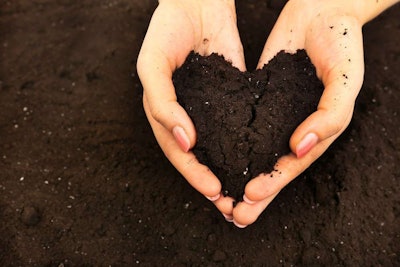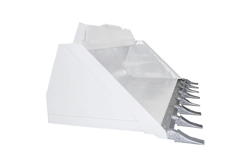
Because soil is the foundation of a thriving landscape, it’s important to make sure your clients’ soil is up to snuff and ready to nourish any new plants you plan to install. Below are some common issues you’ll encounter and how to remedy them.
Soil tests
The true key to caring for any homeowner’s soil is to conduct a soil test. Like flossing, this step is overlooked more often than not, but soil tests can save your company a lot of money when it comes to which products you need to be applying.
“From my standpoint as a soil scientist and agronomist, what I like to see is a baseline soil analysis that can tell you where you stand with your nutrients, where you stand with your with your CEC (cation exchange capacity) and then once you have that you can make an informed decision on whether you need to apply other products to enhance; let’s say your CEC or to increase your nitrogen or something along those lines,” says Mica McMillan, an agronomy services manager with Aquatrols.
Part of the benefit of conducting a soil test is it allows you to begin work on your fertility plans for the growing season and knowing the soil type and current pH levels will let you know which type of plants are going to flourish in particular parts of the yard.
“Soil tests are going to tell you a lot about the soil, and without having an idea of what’s really going on you’re not going to know exactly the best approach to take when it comes to amending or building your fertility program, so I think soil testing is very important,” says James Bergdoll, director of park maintenance for the Department of Public Works for the city of Chattanooga, Tennessee. “I recommend it at least once a year, if not more. If you’re trying to change your soil in some way, you may want to test it more than once a year to see where you are and take that approach.”
Fertilizing
Once you have conducted your soil tests you can go about applying the needed fertilizers.
McMillan prefers to hold off on applying fertilizers if the soil tests come back with everything in acceptable parameters. She then watches to see if the plants begin to struggle, as some of the nutrients that are present in the soil may not be readily available to the plant.
Bergdoll, who is also a Certified Sports Field Manager (CSFM) and member of the Board of Directors for the Sports Turf Managers Association (STMA), says a good remedy for this sort of situation is to apply a specialty fertilizer or micronutrients that can help free up the nutrients that are present but tied up in the soil.
“I think no matter what your soil test might show, whether it’s good, bad or ugly, there are benefits to certain fertilizers,” he says. “It may just be light or focusing on micronutrients or it may not be your standard NPK (nitrogen, phosphorous, potassium) fertilizers. You might be looking at other types of fertilizers and other supplements that might address the plants itself but not so much the soil.”
Another benefit of soil tests is that they take the guesswork out of what nutrients are currently available and whether they are being tied up by chemistry.
“Unless it’s a major deficiency, you’re not going to see that in the plant probably, but a soil test will show you that,” Bergdoll says.
Compaction
A common issue that Bergdoll says he encounters is poor soils caused by new construction where not enough topsoil was used.
“They’ll strip existing topsoil to stockpile and that actually will break down the soil structure itself, and then it gets put back and maybe it’s over-compacted and doesn’t drain well and then causes problems with the plants itself once they’re put in,” he says.
Both McMillan and Bergdoll say conducting aeration can be effective in correcting compacted soils, as it allows for water and oxygen exchange.
Some more intensive methods include performing a deep till in an attempt to loosen the soil as much as possible or removing and replacing the compacted soil with well-draining soil, but Bergdoll says this is the most extreme method you could choose.
“You can also look at soil amendments,” he says. “You could look at something like increasing sand, which is a larger granular size than say silt and clay. It would increase porosity and improve drainage, but you have to use quite a bit of sand to get those results, so I would recommend, if that’s the route you’re going, to evaluate that with a soil lab. Test the particle size and come up with how much that might need to be able to get that porosity and filtration to relieve compaction.”
Erosion
Another challenge you can face is protecting your customer’s soil from erosion, depending on the property’s terrain. Bergdoll and McMillan agree that a good control method for this problem is to have a plant material like a groundcover to hold the soil in place.
“You have to know where your water movement is and be on the lookout for something like that and then you can go back and say either add in some soil amendments to help with that erosion, or you can add in certain plants and groundcover that will help prevent erosion,” McMillan says. “When you’re preventing that erosion in your soils, you’re also helping environmentally by making a choice of, ‘Hey, I’m not leaching any nutrients or any fertilizers or anything that I’m applying to the soil.’ So you should be aware of how that erosion can affect everything that you apply to your soils.”
After knowing the water movement of your client’s landscape, you can create the necessary grading or terracing to manage the runoff better.
“You can’t always have a nice flat surface to work on, so there are ways, terracing and things like that, that you can utilize in that sort of uneven terrain,” Bergdoll says.
Changing the pH
A frequent concern a soil test can reveal is whether the pH level is either too low or too high. McMillan says there tends to be a lot of confusion over what is basic or acidic, and she says it’s important to know what your soil’s baseline pH is before trying to alter it.
“Use a trusted source like an extension agent or a university website and read on there for your specific soil in your specific state,” she says. “What are some of the practices you can do to change that soil pH, because they vary from locations, and what your types of soils are. And there’s really different ways of looking at changing that soil pH, so I always recommend that they go to their local or state extension programs and their university websites to find different ways to change their pH.”
Adding lime is the generally accepted method for raising the pH levels of acidic soil, while organic materials like sphagnum peat moss can be added to basic soils as the material is more acidic. No matter what method you choose to raise or lower the pH levels of the soil, try not to overdo it.
“Don’t do anything drastic,” Bergdoll says. “Don’t expect to change things overnight. Test the soil and follow the recommendations. Go at it in a more gradual sense.”
Maintaining quality soil
Once you have shown a customer’s soil all the tender loving care it needs to get back into quality shape, maintaining that soil is just as important.
“For me, it’s all about every season you’re just watching what amendments you’re adding, and always being aware that when you decide to amend your soils you should take a look at some of the research that’s available on whatever you’re amending that soil with,” McMillan says. “Also, you want to know that two, three years down the road you haven’t closed up pores or created issues where water doesn’t move anymore.”
Bergdoll’s advice is simply to keep doing all the right things.
“Amending as needed,” he says. “Again, going back to soil testing, it’s going to tell you a lot about where you can make improvements. A lot of times it’s probably going to be a lot of organic material in the soil like compost and things like that.”









